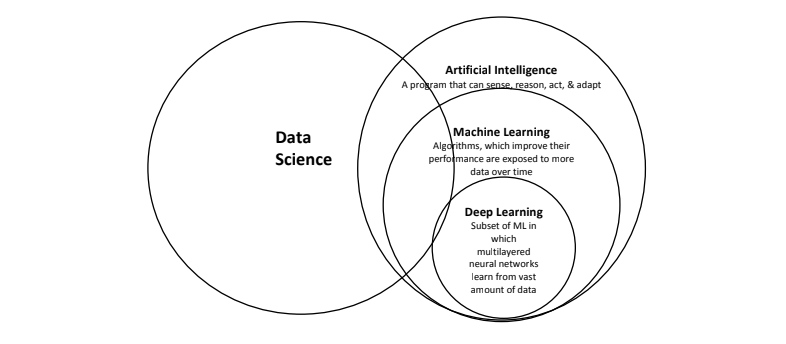Decoding the difference between Artificial Intelligence, Machine Learning, Deep Learning and Data Science
We often get confused with Artificial Intelligence, Machine Learning, Deep Learning and Data Science terms and interpret them in a similar fashion. But, in all practical purposes, the definition an interpretation of these terminologies are different from each other.
Objective of this article is to bring in some amount of clarity on these terminologies to weed out
confusions among the potential data science enthusiasts.
Explore:
- Artificial Intelligence: enables the machines to think intelligently. It means that without any human intervention, a machine will be able to take decisions. It specifically focuses on making the devices more intelligent and thinks as well as act like humans. Such devices are being trained to resolve problems and learn in a better way than humans do. Real life example of an AI application is a self-driving car, which is also known as driver-less car, which is capable of sensing its environment with the help of variety of sensors mounted in it, and moving safely with little or no human intervention. Another aspect, which is worth mentioning here is that an AI application (App) uses ML or DL algorithms to function intelligently. Therefore, the ultimate goal of creating ML and DL algorithms is to build an AI application.
- Machine Learning (ML): a subset of AI that exclusively focuses on making predictions based on past real life experiences. It provides us statistical tools/algorithms to explore the data set and understand the insights hidden in the given data set. ML is an application of artificial intelligence where machines are given access to data sets for the machines to learn from the data
pattern and act intelligently without any human intervention. The ML algorithms are designed in a specific way that learn and improve over time and help the users make better decisions.
Sometime, we receive a call from the bank requesting us to take a loan. Do they call everyone out there? No, they call only selected customers who are accessing similar websites and/or
interested in purchasing their product. Most common examples of a ML application are Alexa or Siri wherein they use machine learning algorithms to learn and act without any human intervention. There three different approaches of machine learning such as
Supervised ML;
Unsupervised ML, and;
Reinforcement Learning or Semi-Supervised ML.
- Supervised ML: uses some past labeled data, which means the output of the data is known before the model is developed, is to make decisions. For example, based on the height and weight of a person, a ML application can decided if he/she belongs to the obese category or fit category.
In case of Unsupervised ML, labeled past data is not used. This type of algorithms can be applied on clustered data to solve business problems. The method of identifying similar groups of data in a data-set is called clustering. For example, if the head of a rental store wants to understand the preferences of the customers
to scale up the business. It is not feasible for the store to look at details of each customer and devise a unique business strategy for each one of them. Instead, the cluster specific strategies can be devised by grouping the customers in different clusters based on their homogeneous buying behaviors. The most basic disadvantage of any Unsupervised Learning is that its application spectrum is limited.
- Semi-supervised learning: an approach of machine learning that combines a small amount of labeled data with a large amount of unlabeled data during training. Semi-supervised learning falls
between unsupervised learning (with no labeled training data) and supervised learning (with only labeled training data).
When we don’t have enough labeled data to produce an accurate model and we don’t have the ability or resources to get more data, we can use semi-supervised techniques to increase the size of the training data. In this type of learning, the algorithm is trained upon a combination of labeled and unlabeled data. Typically, this combination will contain a very small amount of labeled data and a very large amount of unlabeled data.

- Deep Learning: a subset of ML. Idea of using this technique is to create an underlying framework, which is commonly known as artificial multi-neural network architecture. DL studies this artificial neural network that acts very much like a human brain and allows the machine to analyze data in a structured manner as humans do.
For example, researchers working on driverless automobiles are using deep learning to automatically detect objects such as stop signs and traffic lights. In addition, deep learning is used to detect pedestrians so as to avoid any potential accidents. Another impressive example of deep learning is to identify an image and create a coherent caption with proper sentence structure for that image just like a human would write. There are various neural network architecture used in DL namely ANN (Artificial Neural Network), CNN (Convolutional Neural Network), and RNN (Recurrent Neural Network).
- Data Science: the term for a whole set of tools and techniques by which one can analyze data and extract insights from it. It makes use of scientific methods, processes, and algorithms to make this happen. Essentially, its goal is to discover hidden patterns in raw data to help businesses improve and increase their profits.
DS, in fact, applies all the above mentioned techniques apart from some other tools such as statistics, probability, and linear algebra. It integrates all the above mentioned techniques to extract insight from data and make predictions from large data sets. It’s a process as well as a method that analyze and manipulate the data. It also enables us to find the meaning and appropriate information from the large volumes of data.






